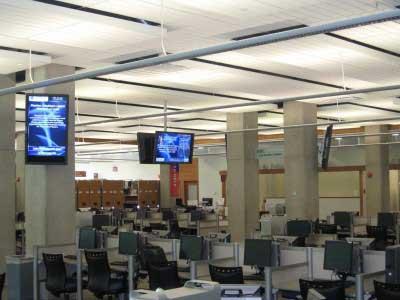By Dmitry Sokolov
In an effort to improve student, visitor and faculty communication, educational institutions of all levels are adopting Digital Signage. Used for way-finding, emergency notifications and other applications, Digital Signage offers the educational sector an effective medium to increase communication. Some leading-edge schools are even incorporating the creation of Digital Signage content into their classroom curriculum.
Sharing responsibility
Replacing traditional message boards and posters, Digital Signage networks enable immediate, up-to-date, highly engaging rich-media content to be shared throughout educational facilities.
Managed by volunteer committees, school communications staff, marketing officers or web administrators, Digital Signage networks can be internal-facing for staff or external-facing for students and visitors.
A collaborative approach to content is becoming increasingly popular, with students and faculty sharing responsibility for the creation and management of Digital Signage content.
“We’re seeing a large increase in schools wanting their students to contribute to—and even take ownership of—their networks,” says John Liberatore, president of MyMedia, a Digital Signage integrator based in Oakville, Ontario. “Where in the past, we were responding to requests to create a largely one-way communication system, (for example, with messaging from staff to students) now student contribution ranks near the top of the requirements list.”
Automatic feeds
In an effort to reduce the costs and complexity of operating these networks, the automation of on-screen content—such as class schedules or photographic and video coverage of school events—is gaining popularity among educational organizations.
Photos are particularly straightforward to feed to Digital Signage in real time, by uploading them to designated shared network folders or public data storage services, like Microsoft SkyDrive, Box.net or Dropbox.
Software-based content approval tools can also be used to curate peer and live content contributions, either with human intervention or by using algorithms that can prevent profane or blacklisted words from getting through.
Managing emergencies
As it is increasingly integrated into crisis management plans, digital signage is also helping educational facilities prepare for—and react to— emergencies. Screens can be connected to existing Internet Protocol based (IP-based) emergency systems and the software can be programmed to display a broad array of pre-set content accordingly, based on types and locations of alarms.
This way, emergency messaging can be localized to each sign in the network. The content can react to a wide variety of scenarios, from school-wide lock downs to hazardous substance leaks in technical training facilities. In these situations, security staff may use mobile apps, web-based tools or texting to trigger and publish alerts via digital signs.

Photo courtesy HP Canada


MyMedia, a Digital Signage integrator based in Oakville, Ontario, has implemented a series of screens in the University of Toronto’s local campus.
Dynamic wayfinding
Digital sSgnage is also rapidly becoming part of many schools’ efforts to enhance the way-finding experience for their visitors.
Whether deployment of the medium involves replacing large, static directories or combining smaller-scale screens with traditional way-finding signs, digital signage allows universities to instantly update their tenant details, class schedules and event information across entire campuses.
And whether the content is static or interactive, it can be published dynamically with updates from building management systems (BMSs) or simple spreadsheets maintained by facility staff. Tablet-computer sized room signs that can integrate with resource-booking tools, including Microsoft Outlook, are also gaining popularity.
This application of Digital Signage is particularly beneficial because it gives schools flexibility to adjust their room and faculty assignments without discarding previous signage.
Leading deployments
Following these trends, along with a growing range of applications, Digital Signage is increasingly becoming a ‘mainstay’ technology of many educational facilities, transforming the experience for students, faculty members and visitors alike.
Signmakers, with their high competency in visual communications, wide-format printing and architectural displays, are often well-suited to participate in or lead digital signage deployments in this vertical market. Any familiarity with interdisciplinary projects that combine print, digital displays and media player personal computers (PCs) in a single design will provide a competitive advantage, though it is becoming increasingly important to be skilled in information technology (IT) and data integration.
That said, the multidisciplinary nature of the digital signage medium often leads to partnerships, with multiple parties collaborating to bring best-in-class expertise to a given project.
Dmitry Sokolov is a Toronto-based retail solutions and thin clients category business manager for HP Canada. For more information, contact him via e-mail [email protected]. http://www.signmedia.ca/trends-‐in-‐the-‐education-‐sector/




